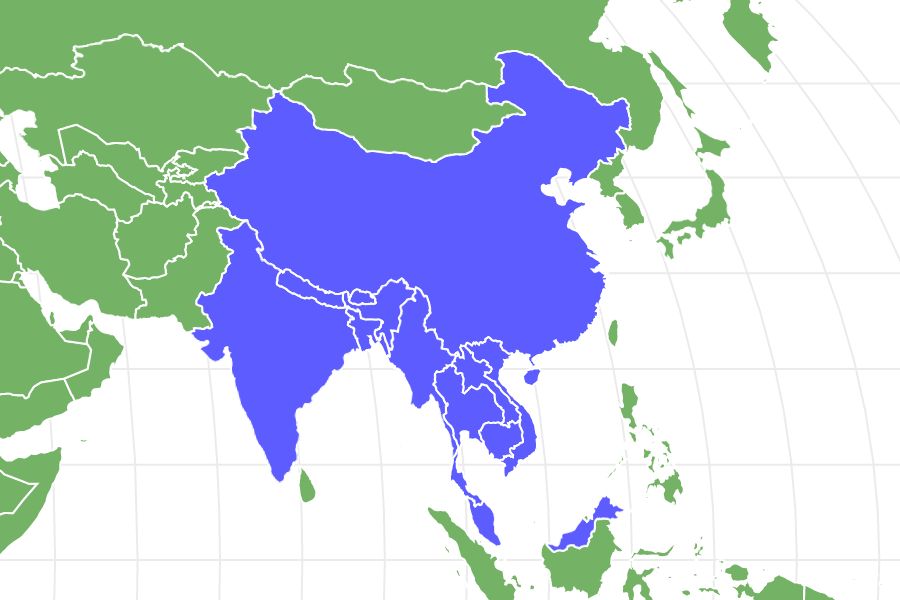Clouded Leopard
Neofelis nebulosa
Has canines that can be two inches long!
Advertisement
Clouded Leopard Scientific Classification
- Kingdom
- Animalia
- Phylum
- Chordata
- Class
- Mammalia
- Order
- Carnivora
- Family
- Felidae
- Genus
- Neofelis
- Scientific Name
- Neofelis nebulosa
Read our Complete Guide to Classification of Animals.
Clouded Leopard Conservation Status
Clouded Leopard Facts
- Prey
- Rodents, Monkeys, Deer
- Name Of Young
- Kitten
- Group Behavior
- Solitary
- Fun Fact
- Has canines that can be two inches long!
- Estimated Population Size
- Less than 10,000
- Biggest Threat
- Hunting and habitat loss
- Most Distinctive Feature
- Dark cloud-like markings and long tail
- Other Name(s)
- Sunda Clouded Leopard
- Gestation Period
- 87 - 102 days
- Habitat
- Dense tropical forest and jungle
- Predators
- Tigers, Leopards, Humans
- Diet
- Carnivore
- Average Litter Size
- 3
- Lifestyle
- Nocturnal/Crepuscular
- Common Name
- Clouded Leopard
- Number Of Species
- 2
- Location
- South-east Asia
- Slogan
- Has canines that can be two inches long!
- Group
- Mammal
Clouded Leopard Physical Characteristics
- Color
- Brown
- Grey
- Yellow
- Black
- Tawny
- Skin Type
- Fur
- Top Speed
- 40 mph
- Lifespan
- 11 - 17 years
- Weight
- 11kg - 30kg (24lbs - 66lbs)
- Length
- 60cm - 110cm (24in - 43in)
- Age of Sexual Maturity
- 2 - 3 years
- Age of Weaning
- 9 months
View all of the Clouded Leopard images!
The clouded leopard is a medium-sized feline that inhabits the dense tropical jungles of Southeast Asia. The clouded leopard is the smallest of the world’s big cats and despite its name, it is not actually that closely related to Leopards and is instead believed by many to be an evolutionary link between big cats and small cats. Clouded leopards are incredibly shy animals and coupled with their highly nocturnal lifestyle has meant that little is known about their behavior in the wild as they are very rarely seen.
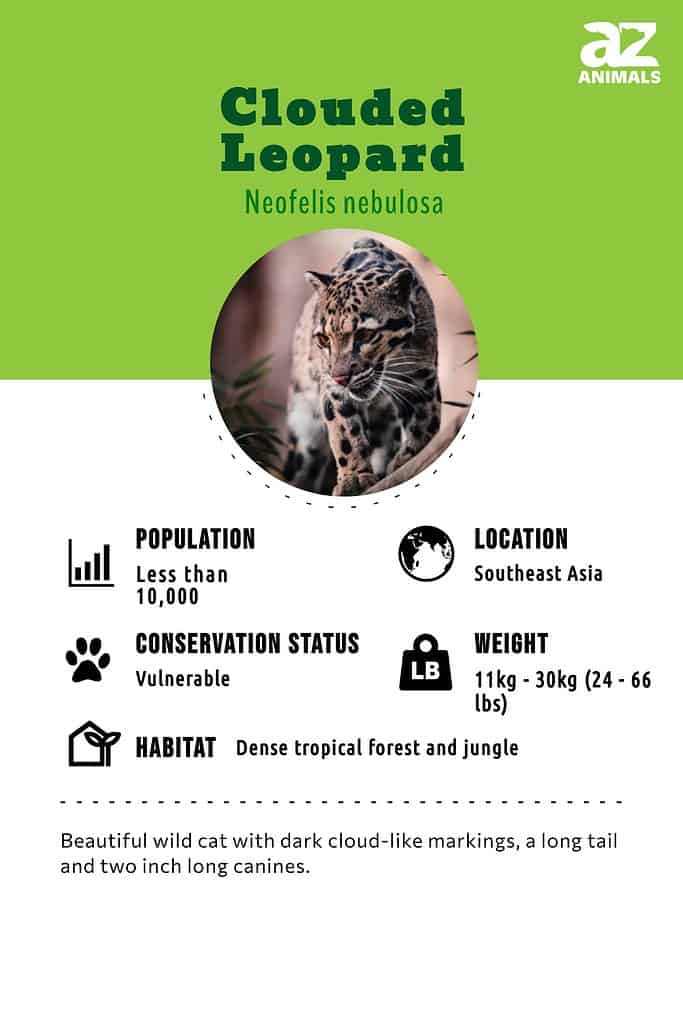
Species
The clouded leopard has recently been split into two separate species which are the clouded leopard (found on the mainland) and the Sunda clouded leopard (Borneo and Sumatra). Both species are already very rare with numbers constantly declining due to the hunting of them for their meat and fur, along with the loss of vast areas of their tropical forest habitat.
Anatomy and Appearance
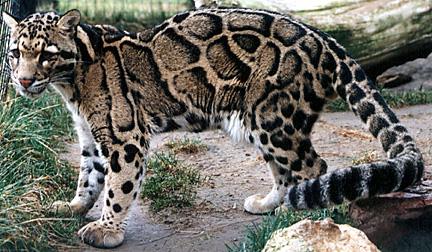
The tail of the clouded leopard is extra long to help it balance while moving through the trees.
The clouded leopard is one the most distinctive of all the big cats and one of the most beautiful. As their name suggests, they have yellow to grey colored coats patterned with large, cloud-like markings that are lined with black and dark in the center. Their small but stocky bodies are supported by short legs and like other cat species (besides the Cheetah), the clouded leopard is able to retract its claws into the skin on its toes to keep them sharp. One of the most distinctive features of the clouded leopard is its rather long canines which can grow up to two inches long, making them about the same length as those of a Tiger. They have two broad black bars on the back of their neck and black rings that run the length of their incredibly long tail. The tail of a clouded leopard can reach 65cm in length and is used to help the animal to balance whilst moving about in the trees.
Evolution
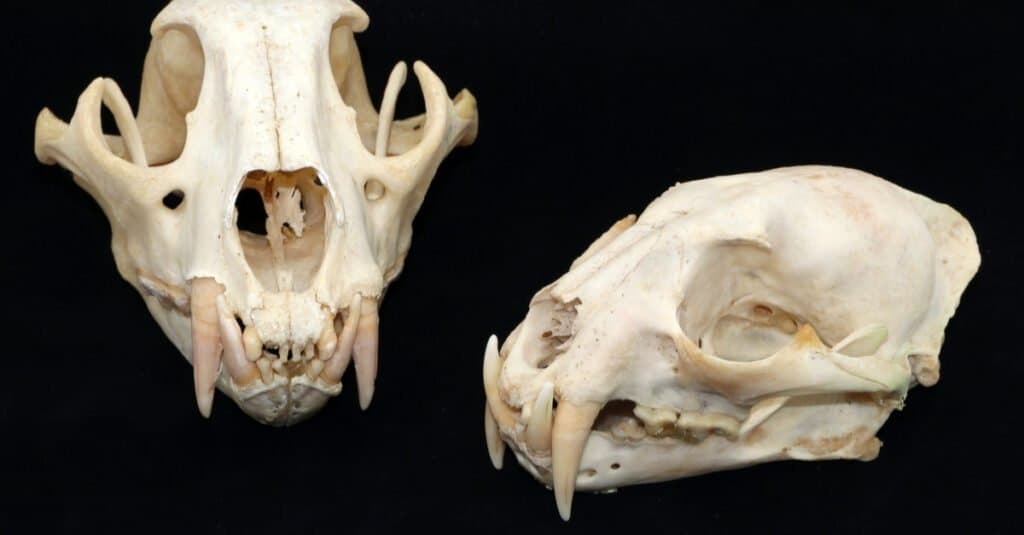
The clouded leopard is believed to be the first cat to diverge from the common ancestor of the Felidae.
©Various images/Shutterstock.com
Fossil records and DNA evidence indicate that the clouded leopard forms an evolutionary link between the big cats, Pantherinae, and small and domestic cats, Felinae. This increase in taxonomic diversity began in the Miocene around 14.45 to 8.38 million years ago in Asia. The clouded leopard is believed to be the first cat to diverge from the common ancestor of the Felidae 9.32 – 4.47 million years ago. The clouded leopard crossed from mainland Asia via a submerged land bridge to Borneo and Sumatra during the Pleistocene and became isolated – diverging into the two current species 2 – 0.93 million years ago.
Distribution and Habitat

Borneo is home to the oldest rainforests in the world and has the largest population of clouded leopards.
©BorneoRimbawan/Shutterstock.com
The clouded leopard is native to Southeast Asian countries including India, Southern China, Burma, Nepal, throughout Indochina, and on the islands of Borneo and Sumatra. It was once also found in Taiwan but is now widely thought to be extinct there. Clouded leopards spend nearly all their lives in the trees and so prefer dense forest habitats including both tropical and subtropical forests and jungles, and at altitudes of up to 2,000 meters. However, despite seemingly only being found in very dense rainforest, the clouded leopard has also been recorded in a variety of other habitats including in tall grasslands in Nepal and in the mangrove swamps of Borneo. The highest population is thought to reside on the island of Borneo but they are threatened throughout their natural range by deforestation to clear land for agriculture or by loggers.
Behavior and Lifestyle
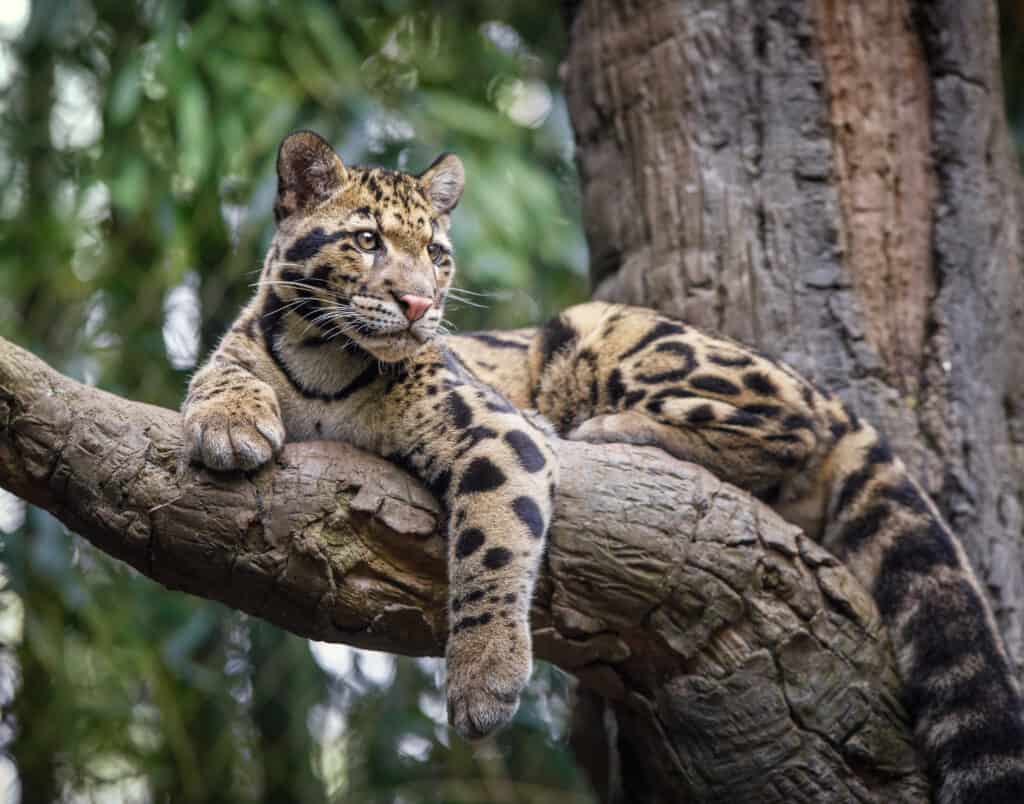
Clouded leopards rest high in the trees during the day and hunt at night.
©jdross75/Shutterstock.com
The Clouded leopard is an incredibly shy and elusive animal that rests high in the trees during the day and actively hunts under the cover of night. They are territorial animals that move just over a mile a day throughout their home range which varies from 50 to more than 120 square miles in size, depending on the region. They are incredibly agile climbers that can speed up trunks and climb about easily in the branches. They have also been observed running head first back down tree trunks and moving along horizontal branches by hanging underneath, using their tails for balance. The Clouded leopard is a solitary animal that marks its territory using urine and scratch marks on trees, however, very little is actually known about their social behavior in the wild.
Reproduction and Life Cycles
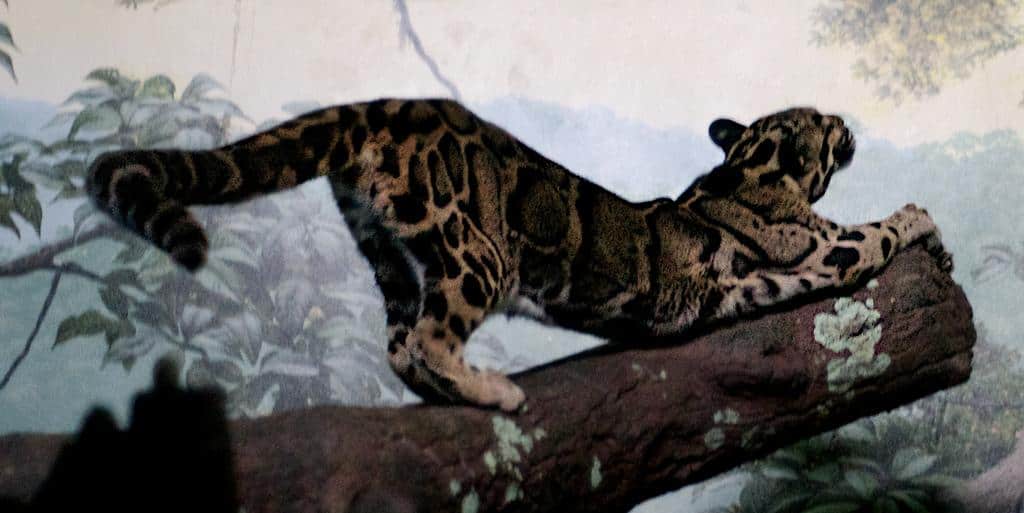
Clouded leopards can live up to 17 years in captivity but little is known about their lifespan in the wild.
Clouded leopard kittens are born in the summer months after a gestation period that lasts for around 3 months. Between one and five kittens are born blind and the large spots on their fur are completely dark in color and don’t develop adult coloration for about six months. Clouded leopard kittens open their eyes by the time they are around 10 days old and are fully active at five weeks of age, beginning to learn how to hunt with their mother shortly afterward. Although they are eating solid food by the time they are 10 weeks of age they are not fully weaned until nine months, when they become independent and leave their mother to establish a territory of their own. Clouded leopards are known to get to 17 years old in captivity but little is known about the extent of their lifespan in the wild due to their incredibly elusive nature.
Diet and Prey

Clouded leopards prey on Pig-Tailed Macaques and other small primates.
©Millie Bond – Copyright A-Z Animals
The clouded leopard is a carnivorous animal that only hunts and eats other animals in order to gain the nutrition it needs to survive. Their preferred prey species is quite dependent on the region where they live as those clouded leopards found in Thailand favor rodents, Ground Squirrels and Porcupines whereas individuals elsewhere more readily hunt primates including Pig-Tailed Macaques, Gibbons, and Proboscis Monkeys. Clouded leopards are nocturnal hunters that either come down to the ground to stalk their prey or lie waiting on a branch to pounce on their victim below. They are also known to hunt birds, Deer, Cattle, young Wild Boars, and livestock such as Chickens and Goats in areas close to human habitation when food in the jungle is hard to find. Clouded leopards are known to retire to the trees once having eaten to rest and let their meal digest.
Predators and Threats
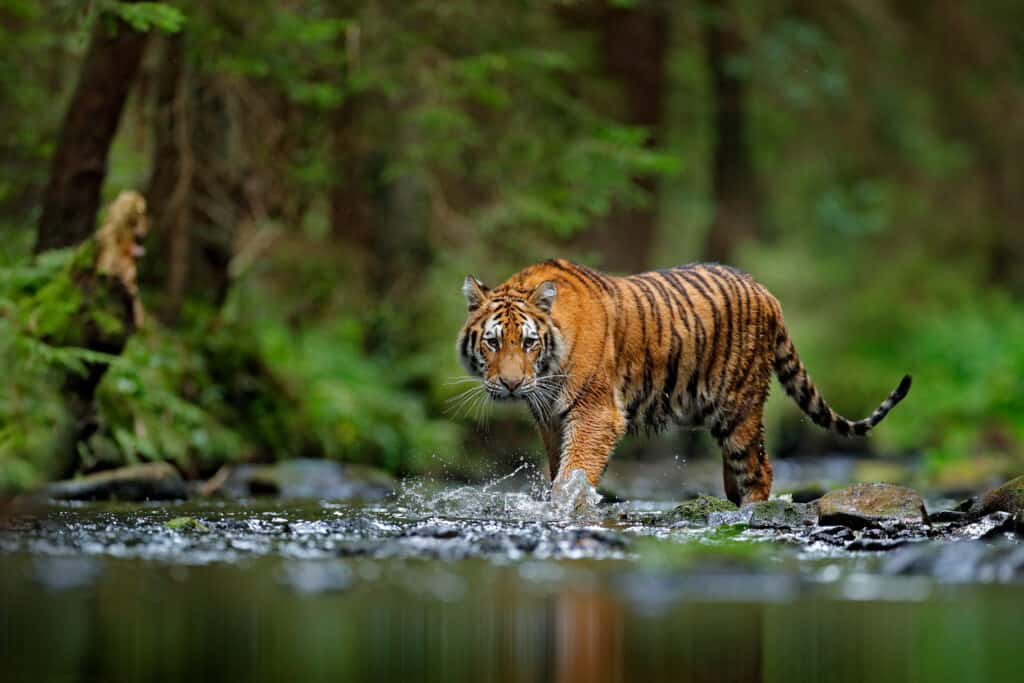
Tigers sometimes prey on clouded leopards but humans are their biggest threats.
©Ondrej Prosicky/Shutterstock.com
Due to its large size and incredibly secretive nature, the clouded leopard has no real natural predators in the jungle with the exception of the occasional Tiger or Leopard with which clouded leopards compete for food. People are the primary threat to clouded leopards as they are hunted for meat and their beautiful pelts, which is a particular problem in certain areas. They are also severely threatened by habitat loss as vast areas of their natural forest habitats are being deforested either to log the tropical timbers or to clear land for agriculture including the planting of oil palm plantations. Increasing levels of human activity, in general, are also pushing the remaining populations deeper still in the forests, making it even harder for experts to try and study them.
Interesting Facts and Features
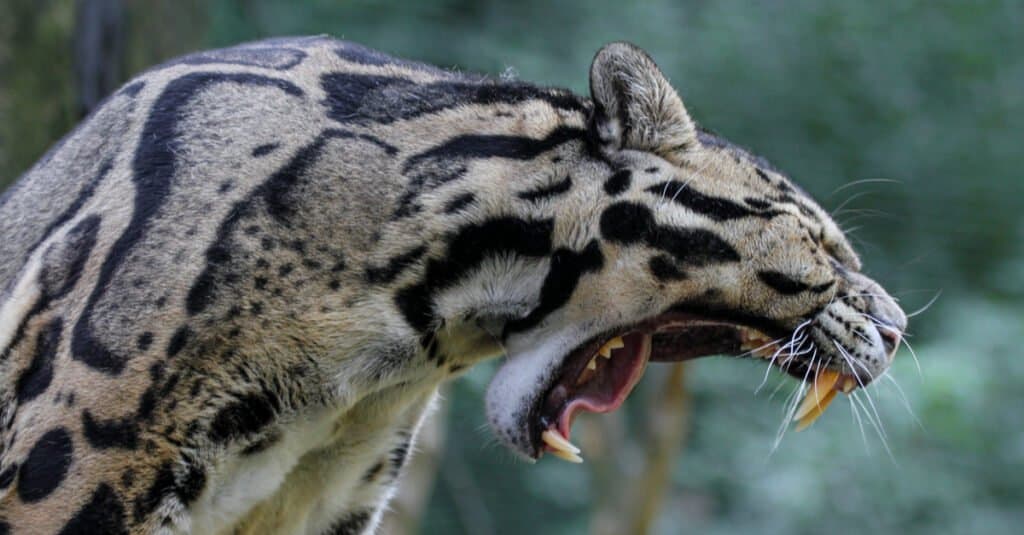
Clouded leopards have unusually long canine teeth up to two inches long.
©Adalbert Dragon/Shutterstock.com
The cloud leopards’ diet is comprised mostly of smaller prey species including rodents and primates. This disproves the previous theory that the animal’s size and large canines were adaptations for hunting larger prey. Although the clouded leopard is thought to only hunt in the dead of night, some individuals have been observed leading a more crepuscular lifestyle and more actively hunting in the early morning or at dusk. Despite the hunting and trading of the clouded leopard now being banned, the practice still continues as people are after their beautifully patterned fur. This is often used in the making of fur coats with just one coat needing the pelts of around 25 clouded leopard individuals to produce it.
Relationship with Humans
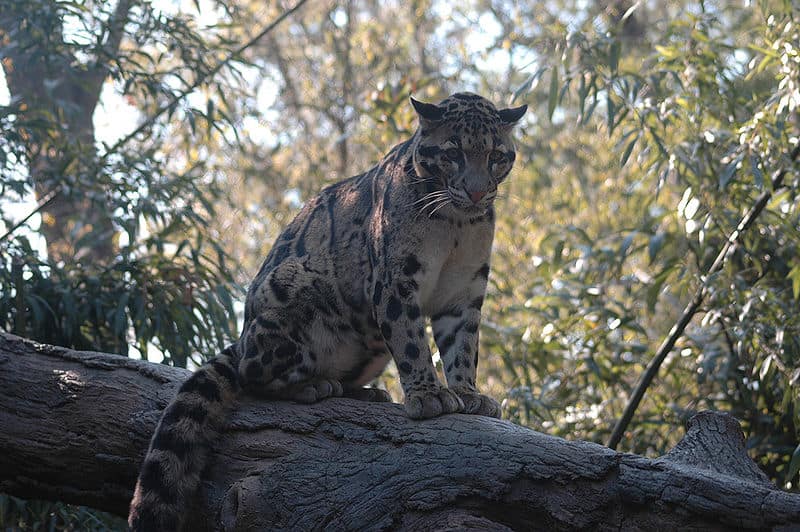
In spite of conservation efforts – people still hunt the clouded leopard for its beautiful pelt.
©Cathleena Beams / Creative Commons – License
People have hunted the clouded leopard for food for many years but also for its body parts. Its beautiful pelt is highly sought after and its bones and canines are often sold to both native people and outsiders for use in medicine and for decorative purposes. Despite being banned, the hunting and trading of their body parts still continue today but the biggest threat to the world’s clouded leopard populations is their rapidly dwindling range. Vast areas of ancient forests are being cleared every day for logging or to make way for palm oil plantations. Land in these regions is often cleared illegally which has devastating consequences in areas that are home to some of the rarest and most unique species on the planet.
Conservation Status and Life Today
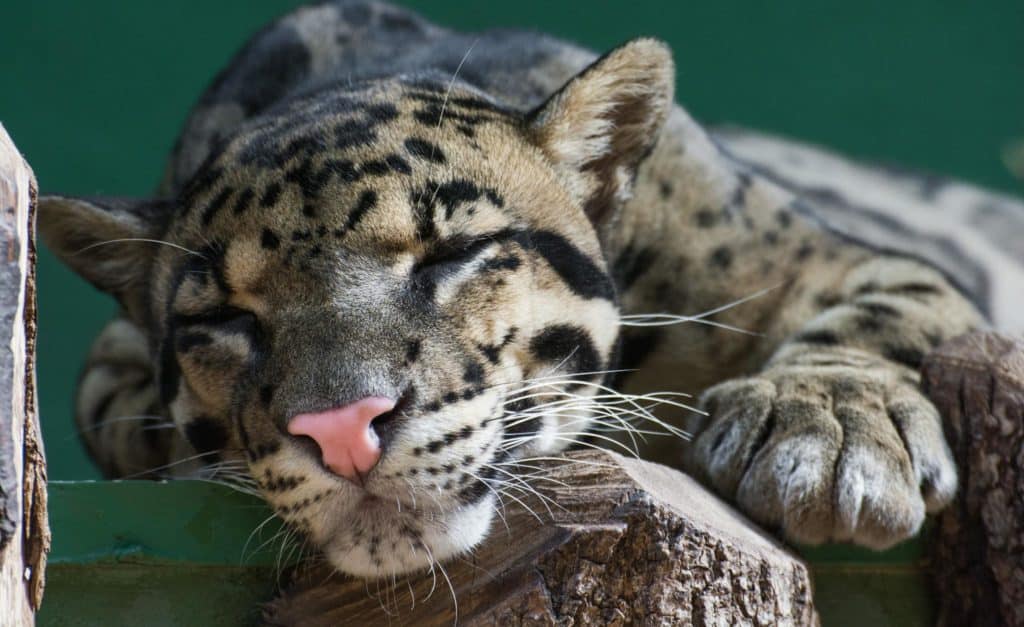
Clouded leopards are listed as Vulnerable to extinction.
Today, both species of clouded leopards are listed by the IUCN as animals that are Vulnerable to extinction from their natural habitats in the near future. It is estimated that there are fewer than 10,000 mature clouded leopard individuals left in the wild, with the highest densities thought to be found on the tropical island of Borneo. However, population numbers are continuing to decline throughout their natural range due to habitat loss and the hunting of them for their fur, with the species having already become extinct from its native habitats in Taiwan.
View all 235 animals that start with CClouded Leopard FAQs (Frequently Asked Questions)
What are the differences between clouded leopards and snow leopards?
Clouded leopards and snow leopards have several key differences. First, the clouded leopard has larger canines relative to its body size than a snow leopard. Second, its smaller and is more prone to climbing trees while snow leopards hunt high in the mountains.
Are Clouded Leopards herbivores, carnivores, or omnivores?
Clouded Leopards are Carnivores, meaning they eat other animals.
What Kingdom do Clouded Leopards belong to?
Clouded Leopards belong to the Kingdom Animalia.
What class do Clouded Leopards belong to?
Clouded Leopards belong to the class Mammalia.
What phylum to Clouded Leopards belong to?
Clouded Leopards belong to the phylum Chordata.
What family do Clouded Leopards belong to?
Clouded Leopards belong to the family Felidae.
What order do Clouded Leopards belong to?
Clouded Leopards belong to the order Carnivora.
What type of covering do Clouded Leopards have?
Clouded Leopards are covered in Fur.
What genus do Clouded Leopards belong to?
Clouded Leopards belong to the genus Neofelis.
Where do Clouded Leopards live?
Clouded Leopards live in southeastern Asia.
In what type of habitat do Clouded Leopards live?
Clouded Leopards live in dense tropical forests and jungles.
What are some predators of Clouded Leopards?
Predators of Clouded Leopards include tigers, leopards, and humans.
How many babies do Clouded Leopards have?
The average number of babies a Clouded Leopard has is 3.
What is an interesting fact about Clouded Leopards?
Clouded Leopards have canines that can be two inches long!
What is the scientific name for the Clouded Leopard?
The scientific name for the Clouded Leopard is Neofelis nebulosa.
What is the lifespan of a Clouded Leopard?
Clouded Leopards can live for 11 to 17 years.
How many species of Clouded Leopard are there?
There are 2 species of Clouded Leopard.
What is the biggest threat to the Clouded Leopard?
The biggest threats to the Clouded Leopard are hunting and habitat loss.
What is another name for the Clouded Leopard?
The Clouded Leopard is also called the Sunda clouded leopard.
How many Clouded Leopards are left in the world?
There are less than 10,000 Clouded Leopards left in the world.
How fast is a Clouded Leopard?
A Clouded Leopard can travel at speeds of up to 40 miles per hour.
What is the difference between a clouded leopard and an ocelot?
The main differences between an ocelot and a clouded leopard are their size, evolutionary history, distribution, and habitat.
How to say Clouded Leopard in ...
Thank you for reading! Have some feedback for us? Contact the AZ Animals editorial team.
Sources
- David Burnie, Dorling Kindersley (2011) Animal, The Definitive Visual Guide To The World's Wildlife
- Tom Jackson, Lorenz Books (2007) The World Encyclopedia Of Animals
- David Burnie, Kingfisher (2011) The Kingfisher Animal Encyclopedia
- Richard Mackay, University of California Press (2009) The Atlas Of Endangered Species
- David Burnie, Dorling Kindersley (2008) Illustrated Encyclopedia Of Animals
- Dorling Kindersley (2006) Dorling Kindersley Encyclopedia Of Animals
- David W. Macdonald, Oxford University Press (2010) The Encyclopedia Of Mammals
- Clouded Leopard Information, Available here: http://www.iucnredlist.org/apps/redlist/details/14519/0
- Sunda Clouded Leopard Information, Available here: http://www.iucnredlist.org/apps/redlist/details/136603/0

